[Last Change: 19 Apr 2019 (rev 4) —
Page History]
UV and IR PSF
The Chandra Optics were not calibrated in the IR or UV, but certainly do reflect and focus images from IR and UV sources. The detector assemblies include filters designed to reduce or eliminate the possibility of such photons' accumulation by the detector. Several observations on both ACIS-I and ACIS-S were made to quantify any IR and UV light leakage, with Betlegeuse observed for the former and Vega for the latter.
Observations
The complete list of ACIS RAW mode data for Betelgeuse (as of 2015 Sep) is:
| OBSID |
Target |
CCD |
Dither |
Yoff |
Xoff |
SIMODE |
Date-Obs |
| 02593 |
Betelgeuse |
I0 |
Nominal |
4.70 |
-5.68 |
TE_00528 |
2002-01-14 13:04:32 |
| 03366 |
Betelgeuse |
I1 |
Nominal |
-4.00 |
-3.68 |
TE_00524 |
2002-01-14 14:46:20 |
| 03367 |
Betelgeuse |
I2 |
Nominal |
4.70 |
2.50 |
TE_00524 |
2002-01-14 16:32:40 |
| 01856 |
Betelgeuse |
I3 |
Off |
0.00 |
0.00 |
TE_0013C |
2000-09-22 11:08:25 |
| 03678 |
Betelgeuse |
I3 |
Nominal |
0.00 |
0.00 |
TN_005EE |
2003-02-06 07:57:42 |
| 05048 |
Betelgeuse |
I3 |
Nominal |
0.00 |
0.00 |
TN_005EE |
2004-02-02 08:48:16 |
| 05963 |
Betelgeuse |
I3 |
Off |
-0.33 |
0.00 |
TN_006E8 |
2005-02-02 13:46:12 |
| 06447 |
Betelgeuse |
I3 |
Nominal |
-0.33 |
0.00 |
TN_00736 |
2005-11-23 10:17:58 |
| 17374 |
Betelgeuse |
I3 |
Off |
-0.5 |
-0.1 |
TN_00C5A |
2014-11-20 04:42:26 |
| 01855 |
Betelgeuse |
S3 |
Off |
0.00 |
0.00 |
TE_0013E |
2000-09-22 12:52:55 |
| 03679 |
Betelgeuse |
S3 |
Nominal |
0.00 |
0.00 |
TN_005F0 |
2003-02-06 06:57:42 |
| 05049 |
Betelgeuse |
S3 |
Nominal |
-0.33 |
0.00 |
TN_005F0 |
2004-02-02 07:51:10 |
| 05964 |
Betelgeuse |
S3 |
Off |
-0.33 |
0.00 |
TN_006EA |
2005-02-02 14:49:43 |
| 06448 |
Betelgeuse |
S3 |
Nominal |
0.17 |
0.00 |
TN_00738 |
2005-11-23 11:22:57 |
| 17376 |
Betelgeuse |
S3 |
Off |
-0.6 |
-0.15 |
TN_006EA |
2014-11-16 08:42:19 |
The complete list of ACIS RAW mode data for Vega (as of 2015 Sep) is:
| OBSID |
Target |
CCD |
Dither |
Yoff |
Xoff |
SIMODE |
Date-Obs |
| 02586 |
Vega |
I3 |
Nominal |
0.00 |
0.00 |
TE_0013C |
2002-02-19 13:03:35 |
| 00036 |
Vega |
I3 |
Off |
0.00 |
0.00 |
TE_0013C |
1999-11-05 09:44:17 |
| 03685 |
Vega |
I3 |
Nominal |
0.00 |
0.00 |
TE_0013C |
2003-01-27 07:50:40 |
| 05046 |
Vega |
I3 |
Nominal |
0.00 |
0.00 |
TE_0013C |
2004-02-05 06:10:26 |
| 05961 |
Vega |
I3 |
Off |
-0.33 |
0.00 |
TN_006E8 |
2005-02-20 21:55:31 |
| 06445 |
Vega |
I3 |
Off |
-0.33 |
0.00 |
TN_006E8 |
2006-01-14 18:30:04 |
| 17373 |
Vega |
I3 |
Off |
-0.1 |
-0.5 |
TN_00C5A |
2015-08-19 15:53:03 |
| 02587 |
Vega |
S3 |
Nominal |
0.00 |
0.00 |
TE_0013E |
2002-02-24 00:38:27 |
| 03686 |
Vega |
S3 |
Nominal |
0.00 |
0.00 |
TE_0013E |
2003-01-27 03:23:16 |
| 00037 |
Vega |
S3 |
Off |
0.00 |
0.00 |
TE_0013E |
2000-06-07 04:40:58 |
| 05047 |
Vega |
S3 |
Nominal |
-0.33 |
0.00 |
TE_0013E |
2004-02-05 05:10:57 |
| 05962 |
Vega |
S3 |
Off |
-0.33 |
0.00 |
TN_006EA |
2005-02-20 22:48:22 |
| 06446 |
Vega |
S3 |
Off |
0.17 |
0.00 |
TN_006EA |
2006-01-14 19:25:55 |
| 17375 |
Vega |
S3 |
Off |
-0.15 |
-0.6 |
TN_00C5A |
2015-08-19 16:35:29 |
This list includes data where the dither was not turned off. It may be possible for some adventurous soul to correct the dithered data.
For completeness, four observations were carried out with SI modes corresponding to 6-chip TE mode:
| OBSID |
Target |
CCD |
Dither |
Yoff |
Xoff |
SIMODE |
Date-Obs |
| 00984 |
Vega |
I0123S67 |
Nominal |
0.00 |
0.00 |
TE_002A4 |
2001-02-01 07:24:10 |
| 00985 |
Vega |
I23S5678 |
Nominal |
0.00 |
0.00 |
TE_002A2 |
2001-02-01 08:40:25 |
| 02594 |
Betelgeuse |
I23S1234 |
Nominal |
-1.00 |
0.00 |
TE_002A2 |
2001-12-07 12:33:18 |
| 03365 |
Betelgeuse |
I0123S23 |
Nominal |
4.50 |
-4.50 |
TE_002A4 |
2001-12-16 00:50:10 |
Observations without dither
This is a list of those data taken with dither turned off. Click on the image to get a FITS file. See below for how the images were created.
| ACIS I3 | ACIS S3 |
| OBSID |
Target |
Yoff |
Xoff |
nmed |
Image |
| 36 |
Vega |
0.00 |
0.00 |
11 |
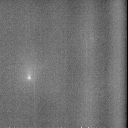 |
| 1856 |
Betelgeuse |
0.00 |
0.00 |
9 |
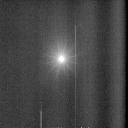 |
| 5961 |
Vega |
-0.33 |
0.00 |
11 |
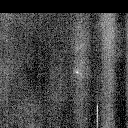 |
| 5963 |
Betelgeuse |
-0.33 |
0.00 |
11 |
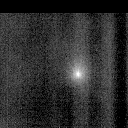 |
| 6445 |
Vega |
-0.33 |
0.00 |
13 |
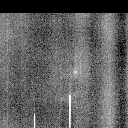 |
| 17373 |
Vega |
-0.1 |
-0.5 |
5 |
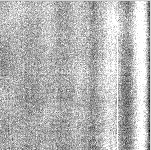 |
| 17374 |
Betelgeuse |
-0.1 |
-0.5 |
11 |
 |
|
| OBSID |
Target |
Yoff |
Xoff |
nmed |
Image |
| 37 |
Vega |
0.00 |
0.00 |
5 |
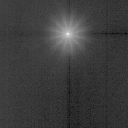 |
| 1855 |
Betelgeuse |
0.00 |
0.00 |
5 |
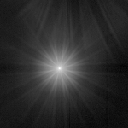 |
| 5962 |
Vega |
-0.33 |
0.00 |
5 |
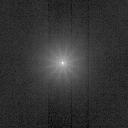 |
| 5964 |
Betelgeuse |
-0.33 |
0.00 |
5 |
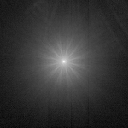 |
| 6446 |
Vega |
0.17 |
0.00 |
5 |
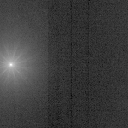 |
| 17375 |
Vega |
-0.15 |
-0.6 |
5 |
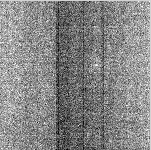 |
| 17376 |
Betelgeuse |
-0.15 |
-0.6 |
7 |
 |
|
Data Reduction
ACIS RAW images are images as read out from the detector (before event processing is performed) with additional bias columns added (eight per node).
Observations were processed with
rawmedadd 
, a Perl script using PDL which
- bias subtracts each frame using the bias columns
- groups the frames
- generates a median image from each group
- sums the median images.
The median process is used to help remove cosmic ray blooms.
The number of frames in each group was adjusted by eye to remove
the majority of cosmic ray blooms. There is significant residual
(non-source related) structure in the resultant image.
Obsid 00037 included some time at the beginning during target acquisition. The raw images
for these 89 frames were excluded from the directory prior to running rawmedadd.
The data were processed with the
nmed parameter as specified in the above table.
Analysis
Richard J. Edgar, NOv 03, 2013
Terrance J. Gaetz, Nov 30, 2017
We had a detailed look at the data which are presented here.
Chandra observed both Betelgeuse and Vega in the raw mode, looking
for optical transmission of the optical blocking filter for ACIS. Each
star was observed on S3 and on I3. Small windows, 150x150 pixels,
were used in order to avoid saturating the telemetry. There are 10 observations which were
not dithered, greatly simplifying the analysis, (Dither would blur the images.)
One round of four observations (two stars by two chips) was done in 1999/2000, another in 2005, and two
observations of Vega were done in 2006. A few dithered observations were
done between 2000 and 2005.
Additional observations with Chandra were
obtained for Betelgeuse in Nov 2014, and for Vega in Aug 2015.
The 2014/2015 images are much fainter than the earlier data,
prompting a reanalysis of the data and a revision to the planning limits.
The previous limits were
based on scaling from Vega, with the assumption that the magnitude of
Vega is 0, and making use of the ratio of the Betelgeuse to Vega fluxes.
The ADUs were summed in a 3x3 pixel region (corresponding to the size of a 3x3
event detection island for X-ray events), and divided by the exposure times to obtain
the rate in ADU/sec/9-pixels.
On S3, the raw mode flux for Betelgeuse in late 2014 was over 200 times fainter than in 2005.
On I3, the Betelgeuse raw mode flux was at least 10 times fainter in late 2014 than in 2005.
For Vega, the source was not clearly visible on either chip. Because scaling from the Vega data
is no longer feasible, the revised estimates estimates are now based on the magnitudes
provided by by simbad:
| |
V |
I |
J |
| Vega |
0.03 |
0.10 |
-0.01 |
| Betelgeuse |
0.42 |
-2.45 |
-3.00 |
For planning purposes, the revised limits were calculated as follows.
[1] For Betelgeuse, SIMBAD provides magnitudes of V=0.42, I=-2.45, J=-3.0.
[2] For Betelgeuse, we have 4.5 ADU/sec/3x3-pixel-island deposited.
Multiply 4.5 by 3.2 to account for the nominal TE mode frame time to get 14.4 ADU/sec/3.2 sec.
The central pixel can have up to 25% of this signal, resulting in 3.6 ADU each frame.
In order to cut this signal to 1 ADU, we need objects 1/3.6 as bright as Betelgeuse.
On S3: fainter than -1.0 (both I and J) can be observed without worry.
[3] On I3: conservatively estimate Betelgeuse at 1.8 ADU/sec/3x3-pixel-island.
This provides about 1.3 ADU in each 3.2 second frame. To cut the rate to
1 ADU per frame, the object needs to be fainter than -2.0 (both I and J).
On I3: fainter than -2.0 (both I and J) can be observed without worry.
For reference, the analysis based on the pre-2014 observations is given below.
 , a Perl script using PDL which
, a Perl script using PDL which














